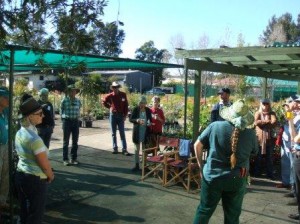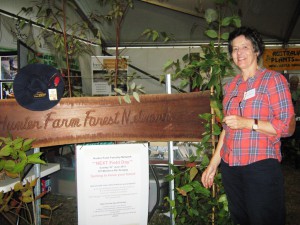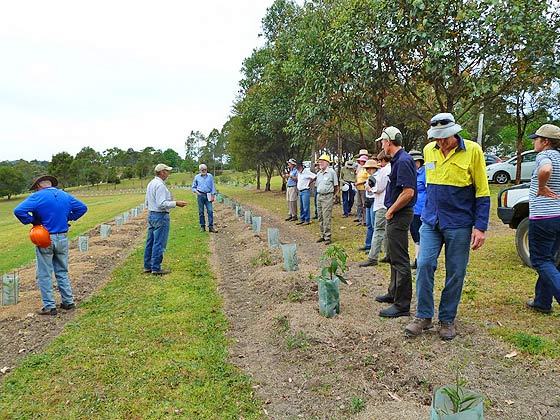August Field Day 2013
Field day at Muswellbrook Forest Nursery on 11 August 2013
Over 20 people gathered at the Muswellbrook Forest Nursery on a perfect late winter’s day. After the customary long morning tea, Pauline Sykes, manager of the nursery took us for an extensive tour of the nursery. Expansion is the word, as the nursery is extending and investing in auto seeding machines. The nursery concentrates on local provenance stock
A couple of dozen Lomandra specimens were potted up after a demonstration that made it look easy.
HFFN member Fred talked about the mysteries of the early life of a Bunya Pine and demonstrated how to get them out of the ground. If you have tried to grow them, had initial growth and then “death”, go and look for the pot now – it is normal and it all happens under the ground.
Pauline talked about collecting seeds and the need for correct labelling and identification. The group went for seed collecting walk in the Muswellbrook State Forest!
Pauline has a love of native plants, a very green thumb and a passion for talking and teaching. Members took advantage of the 10% discount offered by the nursery on the day. It was a great day, thanks to Pauline.
June 2013 Field Day
Judy, Annabel and James gave a very interesting presentation of the work carried out on Judy’s property near Dungog of 250 acres. The property was bought in 2009 and Judy’s aim was to increase its biodiversity and conservation values as well as build a home, cabins, solar array and dam. The house was architecturally designed by a HHFN member (Peter Brecknock) and made use of existing logs and timbers to good effect. An aerial photo taken in the early 1950’s showed that the land was substantially cleared, presumably for logging timber. However, it now has a good mix of regrowth such as iron bark, spotted gum, grey box, white mahogany, and stringy bark trees which now need management as the basal area is over 25. After talks about the aims and methods of silviculture, we were taken to a site below the house where trees have been thinned: Annabel demonstrated how to poison the ‘loser’ trees and discussed which trees should be preserved. The same site was used to look at felled logs with defects to be sold for fire wood: the value of selling them might be $100 per cubic metre less $50 for removal, sawing, splitting, etc. One of the major problems with the forest was the abundance of lantana. After much hand pulling by Judy, two grants from the CMA and The Great Eastern Ranges were obtained to subsidise employing contractors with splatter guns to speed up the removal of the weed. Judy also demonstrated the use of her splatter gun. During the lunch break, Judy’s builder gave an interesting talk on straw bale construction, a method employed to build the bedrooms, cabins and wine cellar. The question that is often raised is: can biodiversity and conservation co-exist with timber production? This property showed how it could be done.
Annabel using a hatchet and poison to kill a deformed tree
TOCAL Exhibit May 3rd – 5th 2013
HHFN provided an exhibit at TOCAL within the CMA site on land care. The messages of the display were to show visitors photos of forest regrowth, examples of cut timber and the damages to the tree that had occurred, information on the next field day, and to provide an outline of what members of HHFN aim to achieve in terms preserving the forests in the Hunter area. Two members of HFFN gave talks on forestry to visitors. Several visitors expressed an interest in joining HFFN and received back copies of the Australian Agroforestry journal.
March 2013 Field Day
Glenn O’Rourke from the RFS at Wollombi gave a very relevant talk on preparing for bush fires to 20 members. He covered four areas:
1. Understanding risk
2. Fire danger ratings and alerts
3. Survival decisions and
4. Property preparation
There is evidence that bush fires are increasing in severity, and hence a new rating has been introduced: “catastrophic”. On catastrophic days, no properties can be defended, and it is necessary to leave the area early. Knowing the Fire Danger Rating can be obtained from TV, radio (local ABC), Internet (RFS site), mobile phones and GPS. A bush fire survival plan is necessary including ways to evacuate: the RFS web site has a guide. Property preparation is to reduce the fuel around buildings. On flat ground 20 metres of slashing and removing the fuel is required: for slopes, 50-90 metres would be required. One clear message is that it is not appropriate to ignore the risk of fires and land holders must have a plan, even if there has been no fire for many years: recall Canberra and Victorian fires.
After lunch, members looked at Pierre Louys’ property near Wards River. Pierre has had the property for 7 years and initially purchased it for environmental reasons. But after courses on managing private native forests, he realised that silviculture was required to allow the better trees to prosper. One area has been harvested and the remainder left alone: 3 trees were measured in each site in 2009 and members measured the diameters in 2013. Two trees in the harvested site grew faster than those in the other site, while data was missing on the 3rd treee.
November 2012 field day
The final field day for 2012 was held at Clarendon Forest Retreat: a resort of 900 acres with a mixture of accommodation, horse riding and forest. There were 20 people present, and Craig Tate presented the work he has carried out advising the owners on how to manage the forest areas. While in the conference centre we were shown an outline of the 900 acres using the Farm Keeper software. One area has been proposed as a conservation area, since it has significant trees, including a large red cedar that must have been missed by the early loggers. At the other side of the property, 10 hectares were classified as a Private Native Forest (PNF), and we walked through this area identifying the trees, how they were marked as habitat, recruitment, and those to keep, with others marked for removal to allow growth for the retained trees. The diversity of the trees was of interest, including flooded and Sydney blue gum, tallow wood, turpentine, grey gums, iron and stringy barks, bloodwoods and a few grey boxes. Bloodwoods are resistant to white ants but susceptible to burning in fires: something to consider when fencing.
After lunch, Ashley Cox, son of the owner, demonstrated the weedicide gas gun that he uses to reduce large infestations of lantana.
October 2012 field day
Twenty nine people attended the field day at the Wootton property, considering techniques for native tree plantation establishment. Chris Scott of NSW Landcare and a nurseryman advised of the need for good overall planning, then to select appropriate plants for the site considering its fertility and order seeds and plants well in advance.
Site preparation can include ripping to at least 400mm depth to attract and maintain moisture, and weeding. Plant into the rip line in association with rain, autumn possibly being the optimum season. Place plants in a bucket of water just prior to planting to provide adequate initial moisture. Management for another two years is advisable considering moisture, weeds, frost and herbivores – mulch and guards can assist.
The group inspected a recently established mixed species native plantation of floodedgum, red gum, tallowood, greygum and brush box, planted along the contour, with a slight fall, using various ripping patterns. “Main” plantings were at 4 metre spacings with a wattle in between to provide a short term nitrogen fix. Growth rates of the plantings, being managed by several different regimes, are being measured as part of the carbon farming initiative.
This was a very informative and enjoyable field day.
August 2012 field day
A sunny Sunday at the 1100 acre Upper Myall property was appreciated by 17 people. The day started with discussion of conservation areas and roading and drainage works. Following a tender process with the CMA, a 300 acre conservation area was established for 15 years, during which time no silviculture activities can occur. An upfront payment from the CMA will cover maintenance, including weed control, cattle exclusion, maintaining fire trails. The practical advice was that road slopes be restricted to 10 degrees if possible and culverts rather than rollovers be used for long term reliability. A minimum pipe diameter of 375mm is recommended to facilitate clearing debris.
The group then drove through the forest stopping to inspect the conservation area, various road sections and drainage structures, and sites where fence posts had been prepared and boards milled with a portable mill. A notably feature was the change in forest type from the dry ridges to wetter gullies.
There was an informative discussion on log pricing. Best price comes from first product ie poles, piles, girders then second product ie sawlogs. The golden rule is that the property owner maintains control of the harvest and sells to a variety of markets.
March 2012 Field day
Twenty three people enjoyed fine weather at the Limeburners Creek property with a long history of timber harvesting from the 1860s up to 1963, when commercial harvesting ceased. Clearing for cattle occurred in 1980. The present owner has no cattle and is trialling various regimes of regrowth management. The area has been mapped and includes areas of old growth forest, mainly areas too rugged for earlier timber harvesting. The next stage is to develop a management plan for ongoing forest management.
November 2011 Field day
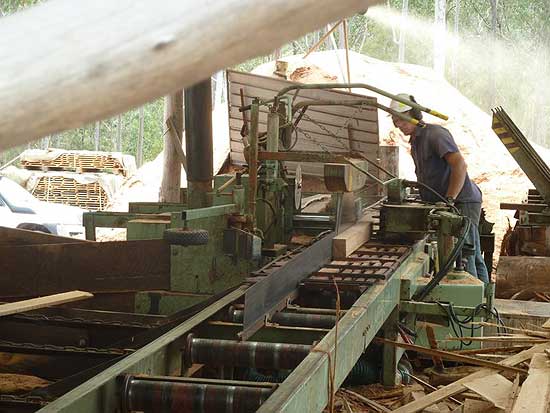 Over 20 enthusiastic foresters attended a very interesting field day in the Upper Karuah valley. There were practical demonstrations of the harvesting machine falling and debarking a tree, the air dried kiln and the milling of a pole into boards.
Over 20 enthusiastic foresters attended a very interesting field day in the Upper Karuah valley. There were practical demonstrations of the harvesting machine falling and debarking a tree, the air dried kiln and the milling of a pole into boards.
An objective of the property’s management is to educate property owmers on sustainable forestry practices. The harvesting regime is seeking to achieve a balance between production and conservation, and over time have a balanced mix of tree species and age. This involves retaining trees, normally taken by contractors, to grow on for future generations.
An important lesson was to find appropriate markets for the processed timber product. In this case timber is being supplied to local, interstate and overseas customers for a range of uses.
July 2011 Field day
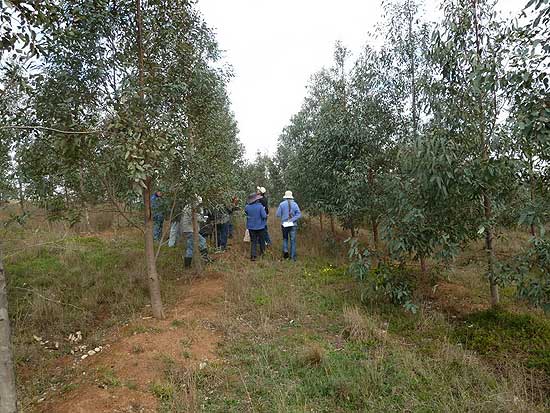 Twenty two people inspected a 80,000 tree plantation, consisting almost entirely of spotted gum, at an Upper Hunter coal mine site operated by Coal and Allied. The forest was established on 80 hectares of land adjacent to the active mine site as part of the greenhouse gas reduction program. Planning and establishment of the plantation was undertaken by Forests NSW and funded by Coal and Allied. Site preparation included ripping and mounding. An initial planting of 47 hectares in Spring 2007 resulted in a 94% survival rate. The second planting in late Autumn 2008 had a lower survival rate; possible causes were frost, attack by hares and kangaroos and dry conditions. A replanting of 10,000 trees was done in 2009. The overall target survival rate has been achieved. An establishment techniques trial area was set up with different plots of deep ripped only, deep ripped and mounded, minimum till, and mounded only, with either nil or appropriate post planting herbicide regime. The trial area is to be monitored over time. Coal and Allied provided morning tea and lunch which were much appreciated by participants.
Twenty two people inspected a 80,000 tree plantation, consisting almost entirely of spotted gum, at an Upper Hunter coal mine site operated by Coal and Allied. The forest was established on 80 hectares of land adjacent to the active mine site as part of the greenhouse gas reduction program. Planning and establishment of the plantation was undertaken by Forests NSW and funded by Coal and Allied. Site preparation included ripping and mounding. An initial planting of 47 hectares in Spring 2007 resulted in a 94% survival rate. The second planting in late Autumn 2008 had a lower survival rate; possible causes were frost, attack by hares and kangaroos and dry conditions. A replanting of 10,000 trees was done in 2009. The overall target survival rate has been achieved. An establishment techniques trial area was set up with different plots of deep ripped only, deep ripped and mounded, minimum till, and mounded only, with either nil or appropriate post planting herbicide regime. The trial area is to be monitored over time. Coal and Allied provided morning tea and lunch which were much appreciated by participants.
